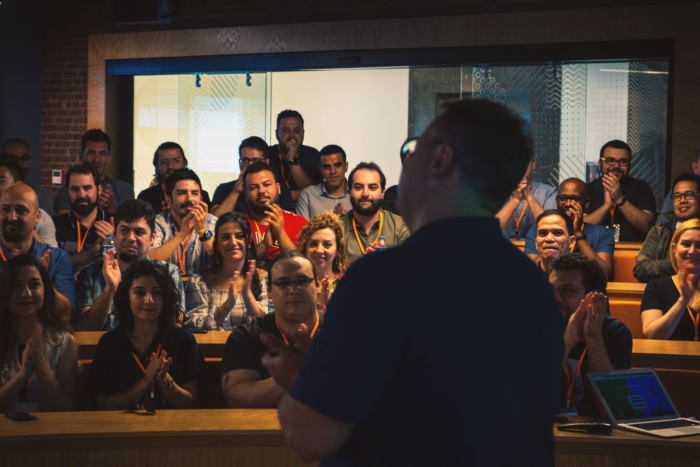A few months ago, Jotform reached an exciting milestone: We crossed the 5 million total users mark. That’s equivalent to the entire population of New Zealand (sheep not included).
I’m thrilled, but mostly, I’m grateful.
Thank you to everyone who has tried and trusted our product over the past 13 years. We’re lucky to have such an engaged user community — and we promise to keep listening and learning.
Our mission is to help people and organizations be more productive. That goal also informs most of my writing. So, in the spirit of marking milestones, I want to share how we arrived at this moment.
Here’s how we bootstrapped the company from its launch in my New York City apartment to a product that serves more than 5 million people worldwide.
Playing the long game
Why bootstrapping beats the rise-and-grind mentality
Over the last decade, entrepreneurship has developed a glossy sheen. We put successful founders like Russell Simmons, Elon Musk, and Emily Weiss on a pedestal and repeat startup clichés like “hustle until the haters ask if you’re hiring.”
Aspiring entrepreneurs often hear that bravery means quitting your job — ideally, tomorrow — to chase a startup dream. After all, passion overcomes all problems, right?
Not exactly. Most people have a small window of time before their funding or their bank account dries up. And leaping into business before you’re ready can create enormous personal, financial, and emotional pressure. Instead of “following your passion,” try to solve problems.
As entrepreneur and Y Combinator cofounder Paul Graham suggests, look for something
- You want and need
- You can build (at least initially)
- Few others realize is worth doing
It’s smart but deceptively challenging advice. Finding that sweet spot isn’t easy, so consider keeping your day job. Start a side project and work until it can sustain you. If that doesn’t sound exciting, consider that Apple, Trello, Product Hunt, Craigslist, and Twitter all began as side gigs.
Successful companies don’t require partnerships, either. Many startup advisors and investors prefer to work with cofounders, but you can fly solo — and it might even be a less turbulent experience.
According to Harvard Business School professor Noam Wasserman, 65 percent of high-potential startups fail due to conflict among the founders. When you’re calling the shots, you can dodge the drama and retain full control of your company.
Spanx founder Sara Blakely, for example, became the youngest self-made female billionaire at age 41. She doesn’t have investors or a cofounder and owns 100 percent of her business.
Navigating the early stages
How to land your first 1,000 users
Huge funding rounds might dominate TechCrunch, but you don’t need deep pockets or VC cash to develop a solid user base. I realize that everyone is unique, and I’d never claim to have a one-size-fits-all approach, but bootstrapping can work — right from day one.
Whatever you’re building, offer a free version. It’s a powerful marketing tool that allows everyone to take the product for a spin. Treat these people well, make it easy for them to dive in, and minimize friction at every point.
While users are exploring the offering, grow an audience with authentic content. Pick the format that feels most natural to you (writing, speaking, video, etc.), and share what you know or what you’re creating. Don’t sell; just be helpful. You can also participate in online forums, join groups, and become an active member of your industry or community.
SEO is another big topic — and it’s an ever-shifting target. My advice? Don’t sweat it in the early stages. If you have the money, you can hire an expert, but clarity is more important than matching the latest algorithms.
Ensure your site is simple and search engine-friendly. Add the content you’re creating and try to lower bounce rates with clear writing and visuals. Collect emails, too. Permission marketing is powerful. According to statistics from the Data & Marketing Association, email generates $38 for every $1 spent, which represents a 3,800-percent ROI.
Put on your blinders and don’t give in to FOMO
Focus on the customer instead
Web forms might not sound like a sizzling market, but Jotform plays in a crowded arena where even Google is battling for customers. After several missteps, I learned that chasing or mirroring our competitors was misguided. It’s important to keep up with big industry shifts, but ultimately, we all have to play our own game.
Once we hop off the competitive treadmill, we can serve customers more effectively. That means
- Listening. Use both praise and criticism to improve. Ask follow-up questions. Clarify what’s still unclear and ensure everyone fully understands the feedback.
- Testing. A/B testing is now a standard process for most digital and product companies, but it helps to take it a step further. Release bigger changes to a small test group, and let them interact with it. For example, when we were preparing to launch Jotform Cards, we switched a small group of users over to the new format and gauged their responses.
- Measuring. Testing isn’t useful if we don’t know what success means. Establish your metrics and the results you’re seeking. Consider giving customers a choice, too. As it turned out, our users wanted to choose their format — and we increased our conversion rates by allowing them to pick what fits their needs.
Hire slowly, fire rarely
Build an ambitious, culture-driven company
“Hire fast. Fire even faster” is another startup cliché. Companies flush with VC cash are often urged to build a team immediately. They’re sprinting, so they need to fill seats in order to scale their offering. I understand this advice, but my own philosophy is more tortoise than hare.
I believe that slow, sustainable growth creates freedom. It also lets you learn alongside your team. Most founders have specific expertise (and a smart idea), but they’re not always natural leaders. That was definitely my experience. Learning how to lead and manage people took time, which is a luxury I wouldn’t have enjoyed if our staff had ballooned overnight.
At Jotform, we don’t hire someone unless we have their entire first-year salary in the bank. This rule ensures we’re ready to take on someone new.
When it’s time to expand, look for people who are genuinely excited and knowledgeable about their field. For example, we’ve noticed that employees with side projects are often standout team members. We also listen closely when top employees refer friends and former colleagues. And consider an internship program. It can feed your organization with a steady stream of talented people who already know the business.
“If you are lucky enough to be someone’s employer, then you have a moral obligation to make sure people do look forward to coming to work in the morning.”
—John Mackey, CEO, Whole Foods Market
Ambitious companies attract ambitious people. Whether you’re designing water bottles or web forms, company culture can make all the difference. Foster a comfortable, positive, and — yes — ambitious, working environment. Give people the tools they need to perform, like powerful computers, course registrations, quiet spaces to think, and natural light. Most important, walk the talk. Leaders can’t preach work-life balance and stay at the office until 11 p.m. every night. Happy, creative, productive people need time to rest.
Smart product development
How to expand and refine what you’ve built
Modern products and services are never finished. We don’t release a version, wipe our hands, and call it a day. If you believe in the continuous improvement model, as we do, you’re always working behind the scenes to make your product better. But sometimes, you want to go big: a sharp design, a groundbreaking feature, a new user interface, or a fresh offering. That’s when you need a plan, which is where our eight-step product development strategy comes in. Here are the basics:
1. Create a strategic plan to guide the year
A big challenge is energizing. Consider dedicating a full calendar year to one major goal, even as you continue improving your core product or service.
2. Work in small, cross-functional product teams
I believe in design-first product development, so all of our employees work in teams of five to six people. Each group includes a lead designer, who works closely with UI and CSS developers, UX specialists, data scientists, and other roles.
3. Kick off with hack weeks
These immersive five-day events spark creativity and innovation. We encourage teams to follow their tangents, but everyone has to end the week with a working prototype, even if it’s buggy or incomplete.
4. Develop quietly, but continue releasing
Show your new version or product to a small user group. Start with 1 percent and gradually take it up to 10 percent of your customer base. Gather feedback, but keep the big reveal quiet.
5. Set and monitor your success metrics
What will success look like? What are you hoping to achieve? Clarify the numbers or the actions you want to see, and watch for those in your early-stage testing.
6. Encourage customers to share their thoughts
Usability testing is invaluable. Watching people interact with your product can reveal both gaps and opportunities. Make it easy for users to comment, both in live sessions and informal ways. Add feedback buttons to your digital platforms and take those submissions seriously.
7. Polish and refine
Untangle the knots in your process months, not weeks or days, before the launch. Ensure your release is ready for its closeup.
8. Make a detailed launch plan
Consider everything that could happen, good or bad, on launch day and address each potential scenario. Prepare for anything — and then raise a glass to everyone who made it happen (customers included).
Build it your way
Back when I was coding after dark, drinking too much coffee, and pacing around my studio apartment, I never imagined that solving a simple but common problem could build a thriving business. I’m humbled every day and feel lucky to work with (and for) incredible people.
Before this sounds like an Academy Awards speech, my point is this: You can do it, too. You don’t have to quit your job or raise millions in funding. You can transform an idea into a product that you’re proud to share. Start small. Listen and learn from your customers — and keep going. Every new user is a step closer to reaching your own big milestone.

















Send Comment:
1 Comments:
More than a year ago
Good on you Aytekin - and your team.
More people should hear your story.
You should get to talk with Guy Raz @guyraz for his @HowIBuiltThis podcasts
Keep doing what you are doing.